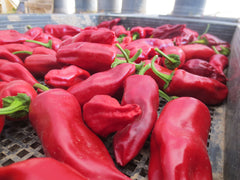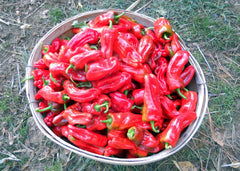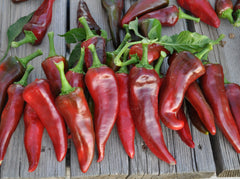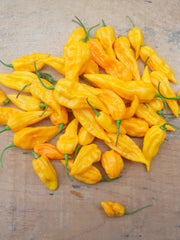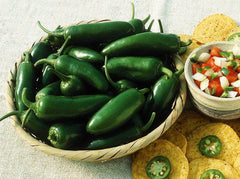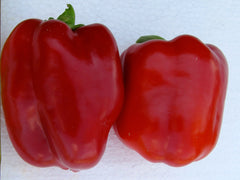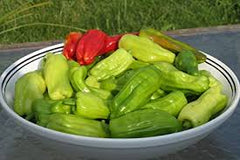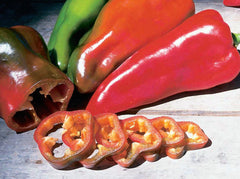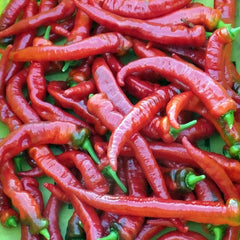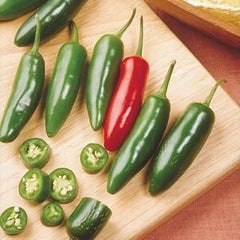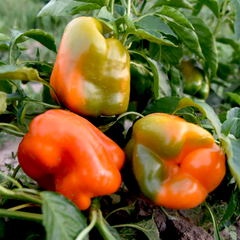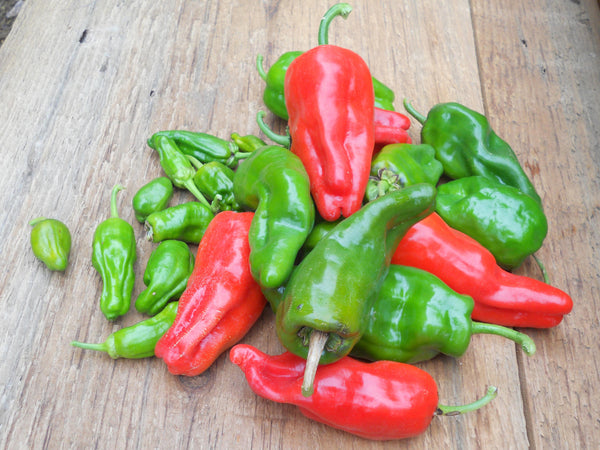Padrón
Capsicum annuum
HOW TO GROW PEPPER, SWEET
Start indoors 10 weeks before last frost, plant out 2 weeks after last frost. When true leave show, pot up to 3-4” pot, grow at 70˚F day and 60˚F night. Plant out when nights are above 53-55˚F. Water in with phosphorus solution. Peppers have shallow roots and appreciate frequent light watering. They thrive on lighter sandy or silt loam soils that warm up fast allowing vigorous early growth before flowering. Use row covers if danger of frost. If you live in a part of the country where pepper plants yield only couple fruits per year, grow more plants. Peppers grow well in containers or raised beds. Soil pH 5.5-6.8. Hardiness zones 9. Annual.
Days from maturity calculated from the date of transplant. Average 3,920 seeds per ounce. Federal germination standard: 55%. Usual seed life: 3 years. Isolation distance for seed saving: 500 feet.
Planting Depth 1/4”
Soil Temp. Germ. 70-85˚F
Days to Germ. 21-30
Plant Spacing 18-24”
Row Spacing 3’
Days To Maturity 60
Full Sun, Moist Well Drained
Days from maturity calculated from the date of transplant. Average 3,920 seeds per ounce. Federal germination standard: 55%. Usual seed life: 3 years. Isolation distance for seed saving: 500 feet.
Planting Depth 1/4”
Soil Temp. Germ. 70-85˚F
Days to Germ. 21-30
Plant Spacing 18-24”
Row Spacing 3’
Days To Maturity 60
Full Sun, Moist Well Drained
- 25 Seeds$4.10
- 250 Seeds$18.50
Spanish heirloom originated in Galicia, northwest Spain. These Italian peppers are grown along the banks of the river Ulla and its tributary Sar, especially in the greenhouses of the municipality of Padrón, hence the name. Padrons are served sautéed in olive oil with a little sea salt and eaten as tapas appetizer in...
Spanish heirloom originated in Galicia, northwest Spain. These Italian peppers are grown along the banks of the river Ulla and its tributary Sar, especially in the greenhouses of the municipality of Padrón, hence the name. Padrons are served sautéed in olive oil with a little sea salt and eaten as tapas appetizer in Spain. The occasional 1 in 20 is hot. “Padrón peppers, some are hot, some are not.” Whether a given pepper ends up being hot or mild depends on the amount of water and sunlight it receives during its growth, in addition to temperature. Typically, there is no way of determining whether a given pepper will be hot or mild, short of actually eating it, though some maintain that smelling each cooked Padrón for spice prior to eating is a good indicator. They are all hot when sized up to 2–3”, about the same as hot Jalapeños. Matures to red, sweeter and somewhat hotter. Tags: Type: Roasting, Color: Green, Heritage: Heirloom, Season: Summer, Certification: Organic.
Learn More
Meet Your Farmer
We promote fair trade, organic practices and environmental responsibility throughout the Restoration Seeds supply chain. Below are the family farmers and seed suppliers who bring our open pollinated seeds to you.
Feral Farm
Certified Organic by CCOF
Seed grower since 2015
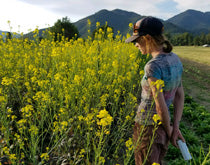

I started growing seed commercially as an apprentice at the Organic Farm School in the Puget Sound in Washington. I already loved growing vegetables, but taking a plant all the way through its life cycle felt like a special kind of honor, and I quickly saw the value in sustaining organic, important, and rare plant varieties and participating in sustainable food systems in this way. I moved to Oregon in 2015 and have been growing my organic seed farming business over the last four seasons by renting land from existing farms and slowly taking on higher volumes and more varieties. I’m currently growing 1.6 acres of certified organic seed crops and heirloom garlic.
Reviews
